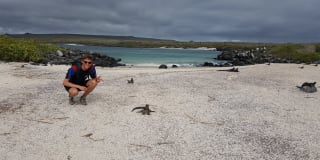The Complete Guide to Snorkelling in the Galapagos
Because of the unique protected wildlife, snorkelling on the Galapagos Islands is an experience like no other. Get up close to majestic sea turtles, penguins, and more.

Beneath the calm, turquoise waters of the Pacific Ocean is a colourful world, so vibrant and alive that it will dazzle you. The waters around the Galapagos Islands have been carefully protected, allowing sea creatures to flourish and thrive as they have on land. As a result, all things great and small make the ocean their home, and snorkelling in the Galapagos will delight underwater explorers, whatever their age.
Paddling on the surface are turtles, sea lions, and penguins, while whales and dolphins jump and dive in the distance. Then, deeper down you’ll see a rainbow of tropical fish and manta rays. The rich diversity of marine life and calm warm waters make the Galapagos reef a snorkeller's paradise, and all its spots are easily reached by boat on a day trip or as part of a cruise itinerary.
Read on to discover where to find the best snorkelling in the Galapagos and make your own magical memories like this.
What Are the Best Months for Snorkelling in the Galapagos?
When choosing the best time to go snorkelling in the Galapagos it’s worth considering the temperature of the water, the weather outside, and what animals you want to see.
The water temperature varies throughout the year, but generally speaking, the warmest temperatures are found during the rainy season, which runs from December to May. During this time, it reaches up to 26 degrees Celsius in some areas, which makes jumping into the beautiful blue water all the more enticing. However, the rainwater can muddy the clarity, making it harder to see the life underneath.
During the dry season, which runs from June to November, water temperatures tend to be cooler, dipping down to around 18 - 24 degrees Celsius, which may be too cool for some snorkellers. But it does mean that the sea is calmer and clearer, offering up some incredible animal sights. Below are the animals you might see in the dry and wet seasons while snorkelling in the Galapagos:
Dry season (June to November)
- Penguins
- Marine Iguanas
- Sea lions
- Galapagos Shark
- Hammerhead Shark
Wet season (December to May)
- Sea turtles
- Manta rays
- Dolphins (Spotted Dolphin and Bottlenose Dolphin)
- Humpback Whales
Snorkelling on a Cruise vs. Snorkelling on Land
Both land-based and cruise-based Galapagos Island snorkelling will open you up to the exciting underwater world below.
If you’re staying in Santa Cruz, there are several amazing snorkelling sites nearby. Some we love are the Itabaca Channel, Tortuga Bay, and Las Grietas – all of which are easily reached by boat trips. Land-based snorkelling gives you a bit more flexibility than a cruise, allowing you to stay in one of the lovely hotels in Santa Cruz like The Finch Bay Eco Hotel, and take day trips out to the reefs. This would suit people traveling to the Galapagos with kids, or those who don’t want to be tied into longer cruise itineraries.
Snorkelling from a cruise, on the other hand, involves a multi-day tour of the Galapagos Islands by yacht. These are more immersive experiences, during which you explore several snorkelling sites and see a wider range of marine life. On top of that, many cruise tours have incredibly knowledgeable naturalist guides who will tell you all about the life and habits of the sea creatures. Cruise-based snorkelling takes you to more remote spots, with an abundance of marine life, less disturbed by human life. If you’re looking for an adventure, fewer people, and more animals, then this type of expedition is for you.
Top 10 Best Spots for Snorkelling in the Galapagos
With years of experience planning idyllic Galapagos tours for guests, and with travel specialists routinely visiting the area to stay on top of the best experiences, these are our top 10 snorkelling sites.
1. Kicker Rock, San Cristobal

Kicker Rock is one of the most popular spots to go snorkelling in the Galapagos, known for its clear waters and bounty of marine life, including hammerhead sharks, sea turtles, rays, and colourful fish. Snorkelling here can range from easy to moderate depending on the conditions. The water is generally calm, but the currents can be strong at times, making it more challenging for less experienced swimmers. The depth varies from shallow to deep, so it is important to be comfortable in the water and have some basic snorkelling skills.
2. Champion Islet, Floreana Island

Located off the coast of Floreana Island, Champion Islet is known for its colonies of sea lions and marine iguanas that sunbathe on its rocks. You might also come face to face with gentle sea turtles, as well as Galapagos sharks, various rays (manta and eagle), bright fish, and even octopus, hammerhead sharks, and bottlenose dolphins. The currents at Champion Islet can be strong at times, making it more challenging for less experienced snorkellers and the sharks, rays, and sea lions could be intimidating for children. However, the water is generally calm, and there are shallow areas where brave beginners can snorkel comfortably.
3. Devil's Crown, Floreana Island

Devil's Crown is a volcanic crater that has eroded over time, creating a circular rock formation with a sunken centre, which resembles a crown. The water within the crater is calm and clear, providing excellent visibility for snorkellers to explore its sea life, however, what really makes this one of the best places to go snorkelling are the colourful corals and sponges. Depths range from 1.5 - 6m, making it an ideal spot for beginner snorkellers.
4. Tintoreras Islet, Isabela Island

The jagged lava rocks of Tintoreras Island off the coast of Isabela Island are home to many prehistoric-looking marine iguanas, the only type of marine lizards that exist in the world. Watch them graze on algae and other marine vegetation, and possibly even see them sneeze out the excess saltwater they snort when eating! While snorkelling here, you might also spy on Galapagos penguins, sea lions, reef sharks, rays, and a variety of colourful fish. The glassy blue water is often calm, creating ideal conditions for beginner snorkellers to get up close and personal with these amazing creatures.
5. Gardner Bay, Española Island

One of the highlights of snorkelling at Gardner Bay is swimming with the playful sea lions, which are known to be very curious and come up close to investigate their visitors. Among the stunning underwater landscape are little reef sharks, eagle rays, and incredible coral formations. This is a great spot for Galapagos snorkelling for all levels as the water is generally still, clear, and relatively shallow.
6. Chinese Hat Islet, Santiago Island

Bolder sea lions are found at Chinese Hat Islet, where they dart and dive among other animals like the white-tipped reef sharks, rays, and penguins. For the more adventurous snorkellers, there are underwater caves and tunnels to explore too. Chinese Hat Islet is fun for children because of the sea lions and the water is shallow, but it also has plenty to keep more experienced snorkellers happy.
7. Pinnacle Rock, Bartolome Island

Snorkelling with Galapagos penguins at Pinnacle Rock is an absolute highlight of any trip to the islands. These clever flightless birds have adapted to the harsh conditions of the archipelago and move at a rate of knots as they glide through the water catching fish. Seeing them in their natural habitat is a humbling reminder of the incredible diversity of life on our planet and how important it is to protect the Galapagos Reef, among others. Bartolome Island’s underwater volcanic formations also attract sea turtles and an incredible array of fish that love to pose for underwater photos, including:
- Yellowtail surgeonfish
- King angelfish
- Hogfish
- Parrotfish
8. Tagus Cove, Isabela Island

The rocks and volcanic formations in this cove on the western coast of Isabela Island provide shelter for a varied collection of fish including:
- Parrotfish
- Angelfish
- Surgeonfish
- Pufferfish
- Damselfish
- Barracuda
- Grunts
While the fish life is diverse, you will also see some of the larger animals like sea turtles, reef sharks, and marine iguanas. The snorkelling here is best suited to intermediate and advanced swimmers because of the strong currents in some areas and the depth of water, which is 5 - 9m deep. However, some areas are fine for beginners too, where the water is shallower and currents less intense.
9. Elizabeth Bay, Isabela Island

Elizabeth Bay is an extensive mangrove forest, which makes for a unique and fascinating underwater environment to explore. Navigate through the winding channels to soak up the diverse ecosystem of plant and animal life. Look out for many of the usual suspects; penguins, turtles, sea lions, sharks, and tropical fish. The waters are also calm, so it’s a good place for Galapagos snorkelling for beginners.
10. Itabaca Channel, Santa Cruz

For amazing snorkelling that can be done without taking a cruise or island hopping, check out the Itabaca Channel in Santa Cruz. Here, you can see plenty of tropical fish, white-tipped reef sharks, and even a blue-footed booby if you are lucky. The currents are low to moderately strong depending on the season, and all snorkelling spots can be done by visitors of all ages and skill levels. If you are not a confident swimmer, you can use a life jacket or floating ring to feel a bit more confident in the water.
Snorkelling Tips and Tricks
- Use a wetsuit: If you’re snorkelling in the Galapagos islands, it is highly recommended to wear a wetsuit when in the water, even during the warm season. The water temperature in the Galapagos can be quite cold, ranging from 15 - 21 Celsius depending on the time of year and location, and a wetsuit can help protect you from the cold water and provide insulation. In addition, a wetsuit will also protect your skin from the sun and potential jellyfish stings or other hazards.
- Protect your skin: The sun can be very strong in the Galapagos, so it's important to wear reef-safe sunscreen and a hat to protect your skin from sunburn.
- Use a snorkel vest: A snorkel vest can provide extra buoyancy and help you conserve energy while snorkelling. They are often provided by the yachts or you can rent one.
- Bring a waterproof camera: The Galapagos Islands offer some of the most unique and breathtaking marine life in the world, so bring a waterproof camera to capture your snorkelling experiences. A lot of our cruise boats also provide them for guests.
Meet our specialists
Call us on 020 8682 5430 to start planning your holiday
Why Scott Dunn?
Unique to You

- We listen to your travel goals and craft unique trips that are bespoke to you.
- We’re with you every step of your life’s travel journey, from honeymoons to family trips and beyond.
Seamless Service

- Global offices in the UK, US, and Singapore for 24/7 seamless service.
- We offer flexibility if your plans change so you can book with confidence and peace of mind.
Carefully Curated Collection

- We’ve curated an elevated collection of accommodation, experiences, and guides.
- Committed to fostering close global relationships to continue bringing you unique experiences.
Luxury in Every Sense

- We deliver a sense of luxury that matters most to you.
- Awarded Condé Nast Traveller’s Top Travel Specialists in the World 12 years in a row.
